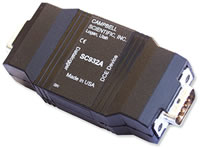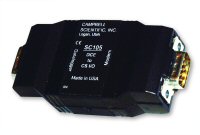18663 Null Modem Cable, 9-pin Male to 9-pin Male
This null modem cable connects RS-232 peripherals to the 9-pin RS-232 port on our CR200-series, CR800, CR850, CR1000, CR3000, or CR5000 dataloggers. Common RS-232 peripherals include our RavenXT-series digital cellular modems and MD485 multidrop modem.
Features
Null modem cable typically connects:
The 9-pin RS-232 port of a CR200-series, CR800, CR850, CR1000, CR3000, or CR5000 directly to the 9-pin port of the digital cellular.
The RS-232 port of an MD485 Multidrop Modem to the RS-232 port of a CR200-series, CR800, CR850, CR1000, or CR3000 datalogger.
The RS-232 port of an RF401-series radio to the RS-232 port of a CR800, CR850, CR1000, CR3000, CSAT3, or another DCE device.
Specifications
Connectors: DB9 male on both ends
Type: RS-232 null modem
SC932A 9-Pin to 9-Pin RS-232 Interface
The SC932A is used to interface a Campbell Scientific datalogger to a modem that is configured with an RS-232 DCE serial port. The SC932A provides true RS-232 signal levels and two-way communication.

Features
Used to connect an RS-232 modem to a datalogger
Commonly used with:
Short haul modems
Fiber optic modems
Satellite transmitters
Cellular modems
Spread spectrum radios
Does not support one way output or printers
Specifications
Communications Rate: up to 115,200 bps
Power Requirements
Source: Datalogger’s 5 V supply
Additional Current: Up to 10 mA may be used by the connected DCE device
Operating Relative Humidity: up to 95% non-condensing
SC105 DCE Synchronous Interface
The SC105 Interface supports communications between a Campbell Scientific datalogger and an RS-232 DCE device. Common DCE devices used with the SC105 include our Raven100, Redwing100, and Redwing105 cellular transceivers as well as third-party radios and modems. The SC105 provides internal buffering that temporarily stores data. This allows the datalogger and DCE device to operate at different baud rates by storing the data received from the faster device until the slower device is ready to receive it. Internal buffering also ensures that no data is lost during transmission.

Features
Supports communication between a datalogger and an RS-232 DCE device
Allows DCE devices to communicate with our dataloggers at rates up to 115.2 kbps
Provides internal buffering capability to ensure no data is lost during transmission
Specifications
Baud rates Supported: 1200, 9600, 19200, 38400, 57600, 115200
RS-232 Parity Supported: even, odd, none
RS-232 Data Bits Supported: 7, 8
CS I/O port modes: CSDC, SDC, ME, Addressed Print Device for P96 output
Power Source: Datalogger’s 5 V supply
Current Drain*
Standby: 0.16 mA
While Communicating: 1 to 4 mA
*Additional current (up to 8 mA) may be used by the DCE device connected to the SC105.
Producing Area:USA